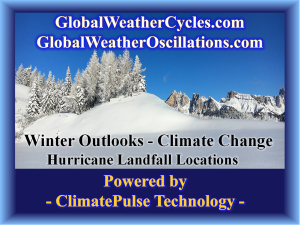2022 Winter Outlook: United States – Canada - Alaska
Transitioning to Global Cooling - Expect Regional Cold Winter Outbreaks to Expand and Become More Dominant and Longer Lasting During the Next Several Winters
It is true the summers have been hotter than normal during the past few years – thus fostering thoughts of runaway global warming. And even the past two winters of 2019-20 and 2020-21 saw temperatures milder than the long-term average across much of the United States into southern most Canada.
However - both winters experienced signs of a transition to global cooling as cold Arctic Vortex cold snaps hit many regions around the world. One of the first signs that a transition to global cooling was beginning - was during the 2020 winter across the high latitudes stretching from Alaska across Central Canada to Greenland. The Arctic Freezer began to repair itself and in return caused very cold Arctic air to build over this region – resulting in the 3rd coldest January and February on record from Alaska eastward into Greenland. This event was the first signal that a global cooling cycle was beginning to kick in – and a sign of what would occur in the following winter of 2021.
In February of 2021, Japan had an intense snowfall killing 13 people. Residents in Spain were in awe over the record snowfall in the streets and snow reaching as far south as Athens Greece. Some areas in India experienced one of its harshest winters in recent memory, and Beijing China recorded its coldest day since the 1960s.
Here in the United States, Texas was hit with a dangerous Arctic blast of winter cold that has not been seen in one-third of a century, and in some locations the most snow in 123 years ago. Even up north where the Dakota’s typically live with cold winter temperatures, the Arctic blast caused the coldest stretch in 78-years. And finally, areas of Colorado and Wyoming were hit by a historical winter snowstorm in March of this year.
So, what is going on? Are natural forces of the earth’s electromagnetic ClimatePulse Cycle repairing the Arctic Freezer that has been malfunctioning during the past 20-years? All signs are pointing to yes - the Arctic Freezer is in a natural restoration mode and is now producing much colder air – just as a freezer should. Observations within the atmosphere during the past two winters – recorded some of the coldest air in over 20-years building across the high latitudes and polar regions of the northern hemisphere.
Professor Dilley says that you can expect the severe regional cold outbreaks around the world to gradually expand and become more dominant and longer lasting during the next several winters. It took 20-years for the global warming cycle #6 to continue warming and reach its peak during the years of 2020 and 202. In the same manner, and it will take 10-years for the global cooling cycle #6 to continue trending downward before reaching its most dangerous cold temperatures during the period from 2030 into the 2050s. But even prior to that period – there will be increasing bouts of regional severe cold and snow – much like the winter of 2022 – but longer lasting and more widespread.
Research by Professor David Dilley shows that global warming cycles like what we have been experiencing - occur approximately every 230-years. There have been 6 global warming cycles since the year 900 AD, with the ending of each warming cycle being followed by a long-term global cooling cycle. Earth is currently transitioning out of Global Warming Cycle #6 and entering Global Cooling Cycle #6.
Global Weather Oscillations (GWO) offers free climate videos describing the earth’s Natural ClimatePulse and associated climate change cycles that will influence the upcoming 2022 winter and beyond. The videos narrated by Professor Dilley - walk you through climate change by collecting data, facts, and proven science. The videos also analyze past and future ClimatePulse cycles - and the most influential forces controlling the climate. It is these natural forces that are now transitioning the climate into a serious Global Cooling Cycle that will by far – be more dangerous than any global warming cycle.
GWO also utilizes their proprietary ClimatePulse Technology for hurricane landfall predictions. During the past 4-years, Professor Dilley predicted the location and strength of all 15 hurricanes that have struck the United States landfalls since the year 2016. Like climate change, hurricanes are also cyclical – especially United States landfalls.
Professor David Dilley
Global Weather Oscillations
+1 352-789-4461
email us here
Visit us on social media:
Twitter
LinkedIn
Legal Disclaimer:
EIN Presswire provides this news content "as is" without warranty of any kind. We do not accept any responsibility or liability for the accuracy, content, images, videos, licenses, completeness, legality, or reliability of the information contained in this article. If you have any complaints or copyright issues related to this article, kindly contact the author above.

